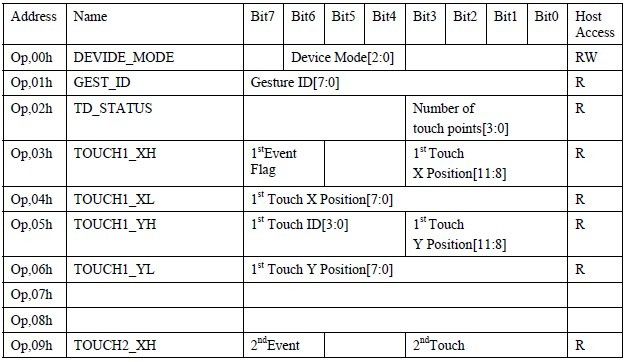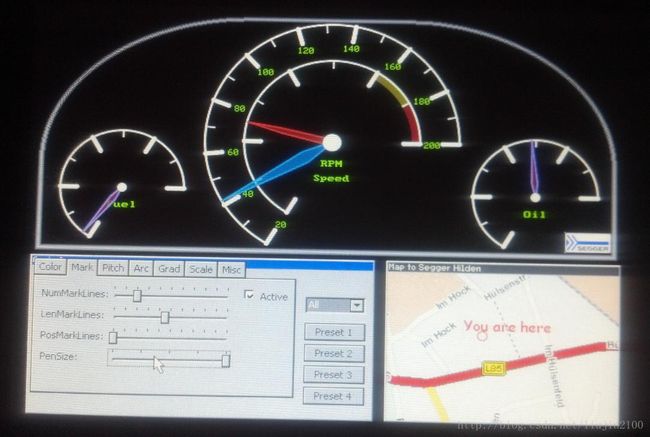我的RTOS 之六 -- Touch移植(s5pv210+threadx+ucgui+touch)
很久没有关注RTOS了,所以也一直没有更新。最近闲了,把GPIO I2C调通了,简单移植了Touch,在S5PV210上使用。
调试I2C时,废了很多周折,最后借助示波器才发现一个小小的错误,折腾了很久很久。
简要说下步骤:
1、首先I2C驱动,使用GPIO I2C的方式
#include
#include
#define DELAY 10
#define SDA 0
#define SCL 1
#define GPD1CON (*(volatile unsigned long *) 0xE02000C0)
#define GPD1DAT (*(volatile unsigned long *) 0xE02000C4)
#define GPD1PUD (*(volatile unsigned long *) 0xE02000C8)
#define GPD1DRV (*(volatile unsigned long *) 0xE02000CC)
#define SDA2_SET_INPUT (GPD1CON &= ~(0xf<<16))
#define SDA2_SET_OUTPUT (GPD1CON = (GPD1CON & (~(0x0f<<16))) | (0x1<<16))
#define SCL2_SET_INPUT (GPD1CON &= ~(0xf<<20));
#define SCL2_SET_OUTPUT (GPD1CON = (GPD1CON & (~(0x0f<<20))) | (0x1<<20))
#define SDA2_SET_VALUE(x) (GPD1DAT = (GPD1DAT & ~(1<<4)) | (x << 4))
#define SCL2_SET_VALUE(x) (GPD1DAT = (GPD1DAT & ~(1<<5)) | (x << 5))
#define SDA2_GET_VALUE ((GPD1DAT & (1<<4)) > 0 ? 1:0)
#define SCL2_GET_VALUE ((GPD1DAT & (1<<5)) > 0 ? 1:0)
void gpio_i2c_init(void)
{
GPD1DRV = (GPD1DRV & ~(0x5 << 10) | (0x5 << 10));
GPD1PUD = (GPD1DRV & ~(0xf << 10) | 0xa << 10);
SCL2_SET_OUTPUT;
SDA2_SET_OUTPUT;
SDA2_SET_VALUE(1);
SCL2_SET_VALUE(1);
}
void i2c_start(void)
{
SCL2_SET_OUTPUT;
SDA2_SET_OUTPUT;
SDA2_SET_VALUE(1);
SCL2_SET_VALUE(1);
udelay(DELAY);
SDA2_SET_VALUE(0);
udelay(DELAY);
SCL2_SET_VALUE(0);
udelay(DELAY);
}
void i2c_stop(void)
{
SCL2_SET_OUTPUT;
SDA2_SET_OUTPUT;
SDA2_SET_VALUE(0);
SCL2_SET_VALUE(0);
udelay(DELAY);
SCL2_SET_VALUE(1);
udelay(DELAY);
SDA2_SET_VALUE(1);
udelay(DELAY);
}
void i2c_send_ack(unsigned char ack)
{
SCL2_SET_OUTPUT;
SDA2_SET_OUTPUT;
if(ack)
SDA2_SET_VALUE(1);
else
SDA2_SET_VALUE(0);
udelay(DELAY);
SCL2_SET_VALUE(1);
udelay(DELAY);
SCL2_SET_VALUE(0);
udelay(DELAY);
}
char i2c_receive_ack(void)
{
char rc = 0;
SCL2_SET_OUTPUT;
SDA2_SET_INPUT;
SCL2_SET_VALUE(1);
udelay(DELAY);
if(SDA2_GET_VALUE) {
rc = 1;
}
SCL2_SET_VALUE(0);
SDA2_SET_OUTPUT;
SDA2_SET_VALUE(1);
return rc;
}
unsigned char i2c_send_byte(unsigned char send_byte)
{
unsigned char rc = 0;
unsigned char out_mask = 0x80;
unsigned char value;
unsigned char count = 8;
SDA2_SET_OUTPUT;
SCL2_SET_OUTPUT;
while(count > 0) {
value = ((send_byte & out_mask) ? 1 : 0);
if (value == 1) {
SDA2_SET_VALUE(1);
}
else {
SDA2_SET_VALUE(0);
}
udelay(DELAY);
SCL2_SET_VALUE(1);
udelay(DELAY);
SCL2_SET_VALUE(0);
udelay(DELAY);
out_mask >>= 1;
count--;
}
SDA2_SET_VALUE(1);
rc = i2c_receive_ack();
return rc;
}
void i2c_read_byte(unsigned char *buffer, unsigned char ack)
{
unsigned char count = 0x08;
unsigned char data = 0x00;
unsigned char temp = 0;
SDA2_SET_INPUT;
SCL2_SET_OUTPUT;
while(count > 0) {
SCL2_SET_VALUE(1);
udelay(DELAY);
temp = SDA2_GET_VALUE;
data <<= 1;
if (temp)
data |= 0x01;
SCL2_SET_VALUE(0);
udelay(DELAY);
count--;
}
i2c_send_ack(ack);//0 = ACK 1 = NACK
*buffer = data;
}
int gpio_i2c_master_send(unsigned int SlaveAddr, unsigned char *Data, unsigned int length)
{
unsigned int i, j;
int rc;
SlaveAddr = (SlaveAddr << 1) & ~0x01;
i2c_start();
rc = i2c_send_byte(SlaveAddr);
if(rc){
printf("i2c_send_byte no ack 1\n");
return -1;
}
for(j = 0; j < length; j++) {
rc = i2c_send_byte(Data[j]);//发送data
if(rc){
printf("i2c_send_byte no ack 2\n");
return -1;
}
}
i2c_stop();//停止信号
udelay(10);
return 0;
}
int gpio_i2c_master_recv(unsigned int SlaveAddr, unsigned char *Data, unsigned int length)
{
unsigned int i, j;
unsigned int data;
int rc;
SlaveAddr = (SlaveAddr << 1) | 0x01;
i2c_start();
rc = i2c_send_byte(SlaveAddr);
if(rc) {
printf("i2c_read_byte no ack 1\n");
return -1;
}
for(j=0; j 2、Touch驱动
Touch IC为 FT5406, slave地址为0x70.
借助博友的一页芯片资料,写了最简单的单点读取:
多点也很简单,可以参考android 多点触控协议上报点
#include
#include
struct touch_data touch_data;
int touch_irq()
{
int i;
int num = 0;
int x, y;
char reg[1] = {0};
unsigned char buf[10];
i2c_read_data(0x38, reg, buf, 7);
if((num = (buf[2] & 0x0f)) == 0)
{
if(touch_data.isPress)
{
touch_data.isPress = 0;
touch_data.x = -1;
touch_data.y = -1;
touch_event(touch_data.x, touch_data.y);
}
//printf("release\r\n");
return 0;
}
x = (buf[3]&0x0f) << 8 | buf[4];
y = (buf[5]&0x0f) << 8 | buf[6];
//printf("num:%d, x:%d, y:%d\r\n", num, x, y);
touch_data.x = x;
touch_data.y = y;
if(touch_data.isPress == 0)
touch_data.isPress = 1;
touch_event(touch_data.x, touch_data.y);
return 0;
}
void touch_init(void)
{
unsigned char uc_reg_value;
unsigned char uc_reg_addr;
unsigned char buf[1];
unsigned char dst[1];
touch_int_setup();
i2c_read_data(0x38, buf, dst, 1);
printf("touch fw:0x%x\r\n", dst[0]);
buf[0] = 0x88;
i2c_read_data(0x38, buf, dst, 1);
printf("report rate:0x%x\r\n", dst[0] * 10);
buf[0] = 0x80;
i2c_read_data(0x38, buf, dst, 1);
printf("touch threshold:0x%x\r\n", dst[0] * 4);
intc_enable(NUM_EINT14);
} 在touch_init 初始化中能够取到touch固件信息,就说明i2c通信正常了。
3、看下效果^^
最后两张的动画比较卡。
4:、存在问题及缺点
由于是电容屏,中断出发,触摸的时候,会不停的上报中断,会导致其他线程block,发生卡顿的情况,尤其画面比较复杂的时候,后期可以采取查询的方法,放在单独的线程当中或者降低touch的报点率;
另外就是lcd只有一层framebuffer,多层显示倒是ucgui的效率低下,后期优化可以同时打开至少两个framebuffer。
5、源码
http://download.csdn.net/detail/liujia2100/8859911
后期尝试移植lwip,搭配arduino,物联网^^.



